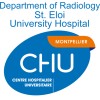
Non Ivasive Prenatal Diagnosis (NIPD) of Cystic Fibrosis
Noninvasive Mucinous Cystadenocarcinoma of OvaryThe purprose of this study is to develop and validate an analytical and clinical NIPD test for cystic fibrosis from maternal blood by analysis circulating free fetal DNA (cff-DNA), searching for the paternal mutation in families with CFTR compound heterozygosity

Intestinal Barrier Function and Liver Cirrhosis
Liver CirrhosisPatients with liver cirrhosis have an increased risk to develop life-threatening complications such as spontaneous bacterial peritonitis (SBP). Impairment in the intestinal barrier, changes in numbers and composition of the intestinal microbiota and alterations in immune defenses have been suggested to be involved in liver cirrhosis and its complications. Dysfunction in the intestinal barrier for example results in the ongoing passage of toxic substances from the gastrointestinal tract that may damage the liver, leading to oxidative stress, inflammation and eventually liver cirrhosis. In addition, bacterial translocation is considered a key step in the development of spontaneous infections, mainly SBP, in patients with liver cirrhosis. The investigators hypothesize that patients with decompensated liver cirrhosis have a more impaired intestinal epithelial barrier and altered intestinal microbiota than patients with compensated liver cirrhosis.

Identification of the Genetic Variants Responsible for Primary Biliary Cirrhosis (PBC)
Liver CirrhosisBiliary2 morePrimary biliary cirrhosis (PBC) is a disease of the liver, which predominantly affects women. It causes slowly progressive liver disease, which eventually causes liver failure, requiring a liver transplant. Several different studies of large patient cohorts indicate that the cause of this disease is likely due to a combination of factors including genetic and environmental. PBC is associated with several other "autoimmune diseases" - recently a gene has been identified to be abnormal in individuals with another autoimmune liver disease, namely rheumatoid arthritis. This gene usually tells the body when to switch off an immune response. This study plans to identify whether individuals diagnosed with PBC have a similar abnormality in this gene called protein Tyrosine Phosphatase.

Study of Total Energy Expenditure in Infants and Children With Moderate to Severe Cystic Fibrosis...
Cystic FibrosisOBJECTIVES: I. Compare the resting energy expenditure using respiratory calorimetry in infants and children with moderate to severe cystic fibrosis versus age matched healthy controls. II. Determine the total energy expenditure and energy spent on physical activity using the doubly labeled water method in these patient populations.

Better Diagnostic Tools for Children and Adolescents With Acute Liver Failure and Chronic Liver...
Liver DiseasesLiver Cirrhosis1 moreThe aim of this study is to validate and develop a new diagnostic and prognostic approach for assessment of liver function in children and adolescents with acute liver failure and chronic liver insufficiency. A carefully selected panel of functional and genomic tests along with diagnostic imaging and analysis of the microbiota will be performed in children and adolescents with acute liver failure and chronic liver insufficiency at Rigshospitalet. The tests will be performed in a serial manner in order to detect changes in outcomes. The study is an unblinded descriptive study, and approximately 20 patients with acute liver failure and 100 patients with chronic liver disease will be included in the project. This study will be the first of it's kind worldwide. The investigators expect the study to improve future diagnostic and prognostic accuracy and help the clinicians in identifying those patients in which the liver will regenerate itself, from those patients in which a liver transplantation will be lifesaving. Furthermore this study aims to help the clinicians in defining the optimal time for pediatric liver transplant in a narrow window of opportunity.

Microbiota Study in Liver Transplanted Patients
CirrhosisHepatocellular Carcinoma2 moreMany studies describe the relationship between microbiota alteration and the occurrence of metabolic, alcoholic or inflammatory liver diseases. Nevertheless, the modifications of microbiota during liver transplantation (LT) as well as its implication are poorly studied. Similarly, only the intestinal microbiota is studied in this context, and no data are available on the biliary microbiota, even if it is known that bile microbiota can interfere with hepatobiliary diseases. This study proposes a clinical and biological in-depth follow-up with multiple sampling of liver transplanted patients to study biliary and intestinal microbiota alterations along LT, as well as bile acids metabolism in corresponding fluids. Indeed, in recipient samples as saliva, blood, urine, and feces can be taken before LT, and surgeons can easily perform bile sampling during LT. In donors all samples can be taken during liver removal. This offers the opportunity to have a microbiotic landscape of individuals without liver disease (donor), and patients suffering from a chronic liver disease or a liver cancer before and after transplantation. Also, in Grenoble University hospital, in case of biliary anastomotic incongruence, a biliary stent is placed during LT in 60% of recipients. This stent is removed by endoscopic retrograde cholangiopancreatography (ERCP) within 6 months after LT, offering a second opportunity to obtain bile samples in transplanted patients, after the early post-LT period. Patients who do not require a biliary stent will also be included for the study of secondary objectives, as intestinal microbiota is very poorly characterized in liver transplanted patients too. A portion of the patients without biliary stent, may also develop an anastomotic biliary stricture requiring an ERCP. If this ERCP is realized within the follow-up period of the study, the patient will also be included in the primary objective of the study. These multiple and sequential samples will allow a complete analysis of microbiota changes in LT patients and aim to answer to 3 questions: What are the modifications of intestinal and biliary microbiomes during LT? What is the influence of bile acids' composition on intestinal and biliary microbiota? What are the relationships between microbiome alterations and the emergence of LT complications?

Risk Assessment After Acute Upper Gastrointestinal Haemorrhage in Cirrhosis
CirrhosisLiver1 moreIn previous studies, the investigators used retrospective analysis of cases of acute upper gastrointestinal bleeding in patients with liver cirrhosis from the Fifth Medical Center of the General Hospital of Beijing PLA, China from January 2018 to May 2019. The investigators performed univariate and multivariate analyses of rebleeding risk and death risk based on all data. Then, based on the analysis of 85% of the sampled data, the investigators randomly selected 85% of the patient data to build a model, and then used the remaining 15% of the patient data for model validation. Re-bleeding risk scores and death risk scores were established, respectively. This study intends to prospectively verify the two risk scoring systems described above. After statistical calculations, about 500 patients with liver cirrhosis who plan to undergo emergency gastroscopy for acute upper gastrointestinal bleeding within the next 5 months at the Fifth Medical Center of Beijing General Hospital of China performed in adult patients. The investigators will exclude patients with incomplete or lost follow-up records. Perform patient self-control,using the existing upper gastrointestinal bleeding risk scores (AIMS65, Rockall, and Blatchford) and the previous scoring system model separately, compared with the actual rebleeding rate and mortality for comparison. To verify and revise the rebleeding risk score and death risk score that the investigators constructed earlier.The data were statistical processed by a professional statistician. The establishment of an acute upper gastrointestinal bleeding rebleeding and death risk scoring system for patients with liver cirrhosis can help distinguish patients with high or low risk of rebleeding or death to determine the patient's treatment needs.

Two-dimensional Shear-Wave Elastography Evaluate Esophageal Varices Bleeding Risk of Liver Cirrhosis...
Liver CirrhosisEsophageal Varices1 moreThe purpose of this retrospective study was to investigate the diagnostic performance of 2D-SWE for predicting the presence of esophageal varices and high-risk varices in patients with liver cirrhosis.

Transient Elastography (FibroTouch) for Assessing Risk of Gastroesophageal Varices Bleeding in Compensated...
Compensated Liver CirrhosisGastroesophageal Varices BleedingGastroesophageal varices occurs in approximately half of the patients with liver cirrhosis. Variceal bleeding is the most common lethal complication directly from cirrhotic portal hypertension. The golden standard for diagnosing gastroesophageal varices and evaluating the risk of variceal bleeding is the esophagogastroduodenoscopy. According to the Baveno VI consensus, for those with high-risk varices (varies needing treatment), either non-selective beta blockers or endoscopic band ligation is recommended for the prevention of the first variceal bleeding. However, the invasiveness and uncomfortableness during the esophagogastroduodenoscopy procedure has hindered its routine use in clinical practice, especially in compensated cirrhotic patients. The important role of transient elastography for defining the presence of high-risk varices was highlighted in the Baveno VI consensus workshop that cirrhotic patients with a liver stiffness measurement (LSM) of less than 20 kPa and a platelet count of greater than 150,000/μL can avoid screening endoscopy. In addition, transient elastography-based models (e.g. LSM combined with platelet count, liver stiffness spleen diameter-to-platelet score) were shown to have potentials in distinguish the absence of high-risk gastroesophageal varices. However, this cutoff value of LSM was validated mainly in cohorts with alcoholic or hepatitis C virus dominated cirrhosis. The unmet need is a precise cutoff to rule out high-risk varices in hepatitis B virus dominated cirrhosis, which is an outstanding issue in Asia-Pacific population. FibroTouch (Hisky Medical Technologies Co. Ltd, Wuxi, China) is a new-generation of transient elastography based on a two-dimensional image-guided system to ensure the precise orientation. In the present study, the investigators aim to conduct an international prospective diagnostic trial with 16 sites to develop and validate the diagnostic performance of FibroTouch-based models for assessing risk of gastroesophageal varices bleeding in compensated cirrhosis.

Gastrointestinal Study at Orkambi Therapy in CF Patients
Cystic FibrosisIvacaftor caused a significance increase in weight in patients carrying the G551D mutation and the etiology of this has largely remained unknown but may be due to improved function of the gastrointestinal tract. The combination therapy of Orkambi has been recently approved for subjects with Cystic Fibrosis homozygous for F508del mutation. This provides an opportunity to examine if there are any improvements in gastrointestinal function. The investigators aim to investigate various aspects of gastrointestinal and pancreatic function before and 6 months after the commencement of Orkambi therapy.
